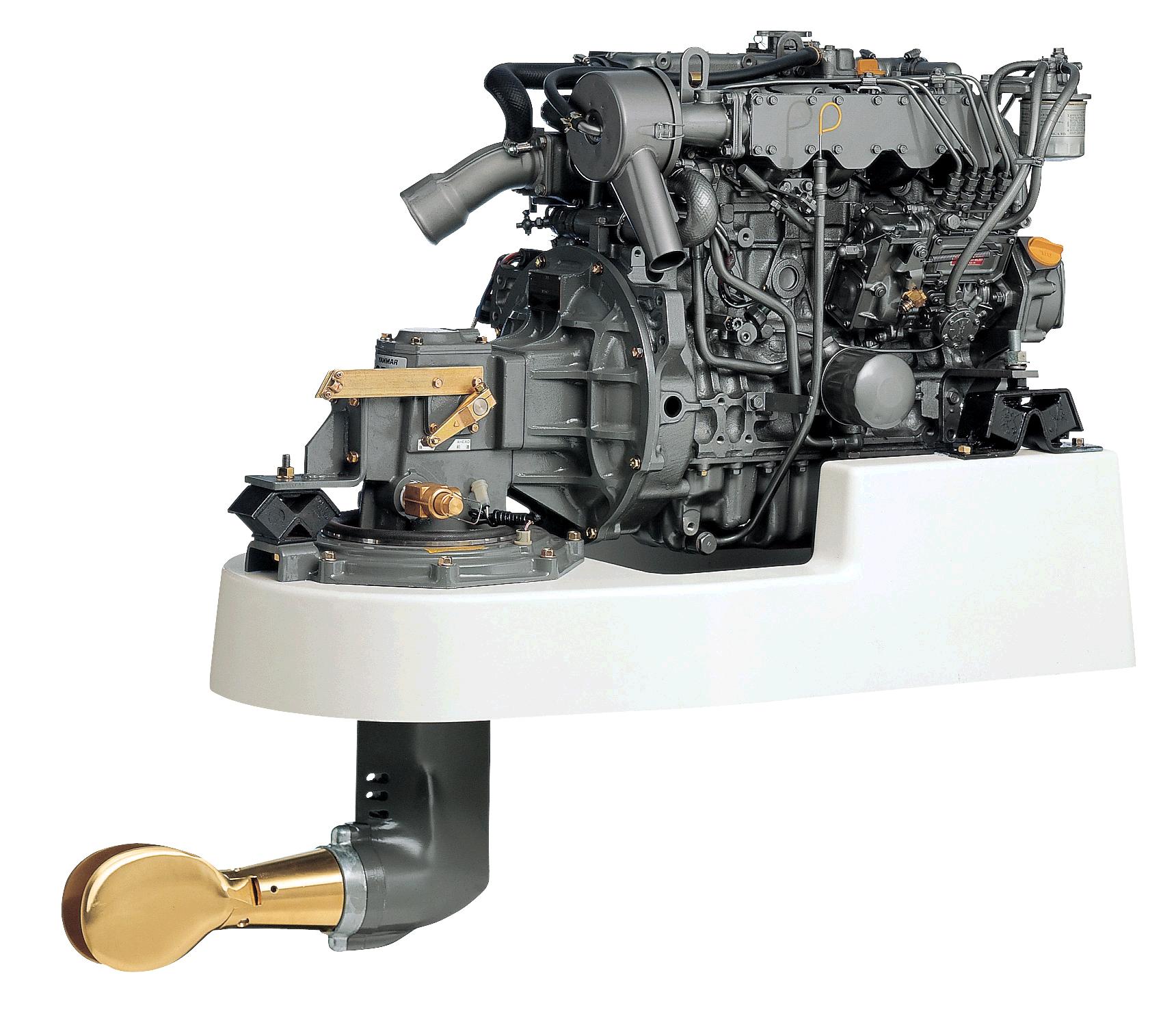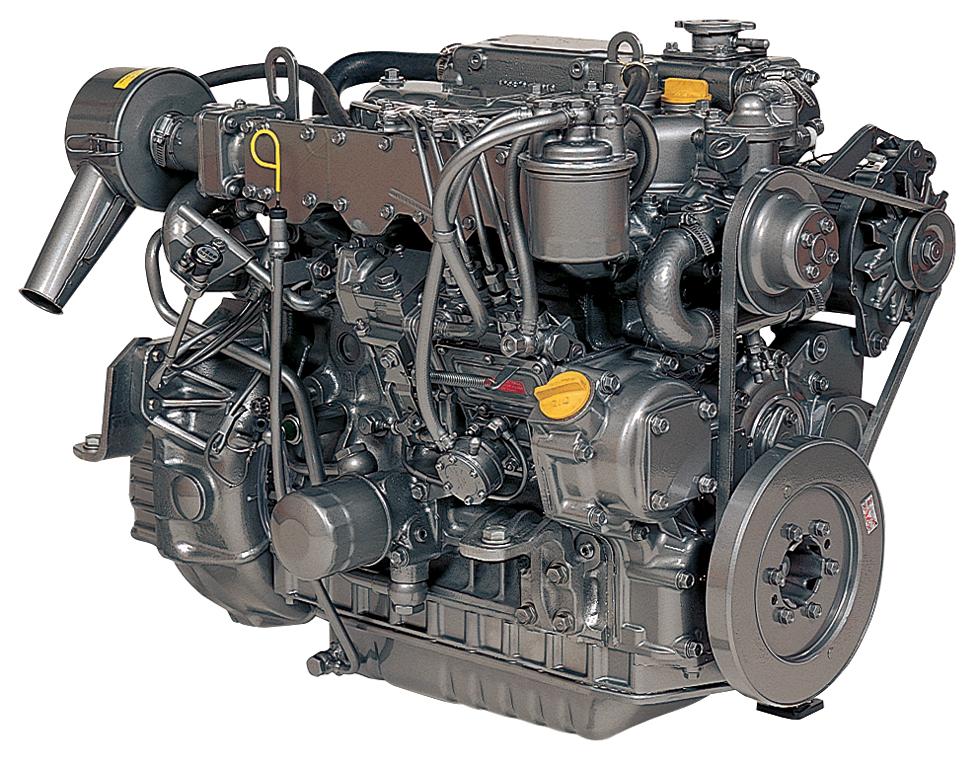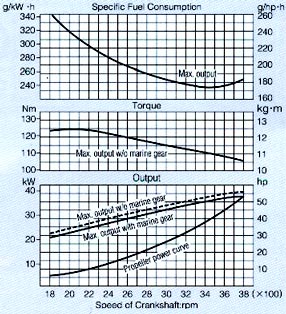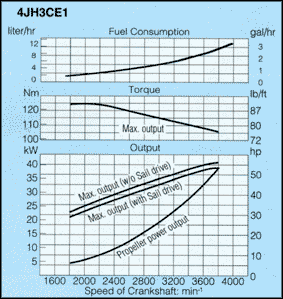Alegria's propulsion system is a Yanmar 4JH3CE1
Saildrive. This combines a Yanmar 4JH3 diesel engine with an SD40
saildrive unit to make an attractive package for easy installation in
sailboats with relatively flat bottoms aft of the keel. The saildrive
concept avoids issues with coupling alignment because there is no coupling
and can use softer motor mounts which significantly reduces vibration
transmitted to the hull.
The front of the engine is readily accessible making routine maintenance quite easy

The standard saildrive comes with a Gori folding propeller which is one of the common complaints with the saildrive units, the other being that significant periodic maintenance CANNOT be performed in the water. Specifically the saildrive manual states that the single zinc on the saildrive should never be replaced in the water as removal of the propeller from the saildrive is required, additionally, it is preferable to change the saildrive/transmission fluid by pulling a plug in the bottom of the underwater drive leg. The transmission fluid can be changed in the water by sucking the old transmission fluid out of the fill hole but this does not get all of the oil.
A significant issue in King Harbor (Redondo Beach, CA) is that the harbor tends to be "galvanically hot" and the zinc anodes on a vessel tend to need replacement every couple of months as compared to every year or so in most marinas. Thus, the MaxProp with it's additional zinc anode on the end of the propeller hub provides some additional protection which can in fact be replaced easily in the water.
The 18" Gori folding propeller did not have any markings to suggest what it's pitch is so the folks at PYI did a bit of research and determined a good starting point would be 18 degrees of pitch which is 11 inches of pitch. This was based upon our observation that Alegria moved at about 7.3 knts in flat water with no wind while the engine was turning at approximately 2900 RPM. The maximum RPM which could be achieved in gear was approximately 3400 RPM under the same conditions with a significant amount of vibration. Performance in reverse was as usual for a folding propeller quite pathetic.
The MaxProp at the recommended initial setting of 11 inches of pitch allows the engine to achieve it's maximum governed RPM of 3800 without vibration or strain. PYI has the installation manual for the classic three bladed Maxprop online and I have cached a local copy here. Note that the manual makes few comments about the saildrive version which uses a toothed hub rather than a tapered shaft. Also note that replacement of the saildrive zinc still requires removal of the prop which in the case of a MaxProp means completely disassembling the propeller. PYI does give some instructions for installing the saildrive zinc anode in such a way that the propeller does not have to be removed but it does not appear to apply to the SD40 configuration. (In fact after consulting with the folks at PYI about the instructions for cutting the "thrust bearing" to allow replacing the saildrive zinc without removing the MaxProp do not apply to the SD40 configuration, the diameter of the propeller hub is too large to allow that option). The selected prop is definitely an 18" version.
The settings for 18 degrees of pitch (11 inches of pitch on an 18" prop) with left handed rotation (supposedly all sail drives are left handed rotation) has the X setting (i.e. the spline with the hash cut into it) at position "N". The Y setting (i.e. the dot in the hub) at position "B". Getting the Y setting off by one tooth will result in about 20 degrees additional or reduced (depending on direction) pitch and should be very obvious.
The comfortable cruising RPM to achieve 7.3 - 7.5 Knts on flat water is approximately 3200-3300 RPM. I verified with the local Yanmar distributor (The Boatswains Locker) that the ideal long range cruising RPM for this engine is between 2900 and 3400 RPM and that the rated continuous operating RPM is 3650. The governed RPM of 3800 is acceptable for short duration operations. The Spec sheet for the engine and the engine with the saildrive are available here and on their web site.
Another source recommends the following as the appropriate values for engine RPM for this engine:
|
Idle
|
High
Idle
|
Full
Load*
|
Prop
Match*
|
|
RPMs
to Attain
|
800
|
4000
- 4100
|
3600+/-50
|
3700
- 3750
|
An interesting observation is that the specific fuel consumption curve shows the engines most efficient RPM to be 3400-3500 RPM. At 3300 RPM the engine is capable of producing 48HP and the propeller power curve shows that approximately 35HP can be applied to the water at this RPM.


The curves on the left are for the engine itself, the curves on the right are for the specific instance of the 4JH3 Yanmar diesel coupled with the SD40 saildrive. Note that the fuel consumption curve on the left is in grams per hour per horsepower while operating at maximum output for that RPM. The curve on the right is in Gallons/hour assuming the engine is performing at maximum output for a given RPM. i.e. if the engine is turning at 2000 RPM is is capable of producing about 30 HP and will consume 1 gallon/hour if you use all of the output of the engine, at 3800 RPM the engine can produce 56 HP and will consume a little over 3 gallons/hour. However, if the engine is running at 3800 RPM and is only asked to produce 30HP the consumption will be closer to 1 gallon/hour. In fact the curve on the left specifies for a given RPM the number of grams of fuel consumed for each HP produced for one hour.
From this information we see that Alegria should be be running the engine at about 3200 RPM for maximum efficiency assuming that a speed of 7.3-7.5 knts is desired i.e. if we assume that we needed 10 hp to move Alegria at 7.3 knts, the propeller curve shows that the minimum RPM where this much energy can be applied to the water is 2200 RPM (Crankshaft RPM, not propeller), the engine is capable of producing 35HP but the propeller cannot apply more than 10HP to the water. Thus, if we were need more HP to move her at 7.3 knts (caused by seas, headwinds, etc) then there would be no way to apply the extra HP necessary. Additionally she would consume approximately 1 gallon of fuel per hour to move Alegria at 7.3 knts on flat water.
However, if we pitch the prop to move Alegra at 7.3 knts at 3300 RPM it still only requires 10 hp from the diesel engine. The engine is capable of producing 50HP and the propeller is capable of putting 35HP into the water. Since a diesel engine consumes fuel roughly in proportion to the HP the engine is providing (minus a little bit of fixed overhead) at a given RPM we see that at 2200 RPM the engine consumes 220 grams of fuel per hour for each HP produced, but at 3400 RPM the engine consumes only 175 grams of fuel per hour for each HP produced. Thus for the same sea state at 2200 RPM the engine will consume 1 gallon/hour while at 3400 RPM the engine will consume 175/220 * 1 gallon per hour = 0.8 Gallons/hour or about 20% less fuel per hour. Going from 2900 RPM cruising to 3400 RPM cruising results in a ratio of 175/190 = 0.92 or about 8% more efficient at 3400 RPM.
This higher RPM also means that each stroke of the engine is having to produce less energy and is in fact EASIER on the engine than running at lower RPM. Note that these curves are VERY engine specific. To perform the same calculations for a different vessel requires the curves for the specific engine installed. Also note that 10 is a guess at the HP required to push Alegria through the water, there are some simple calculations which can derive this number and I will try and update it soon.
Golden